The expressive, yearning sound of the kamancheh, a traditional Iranian bowed string instrument, kaleidoscopes in and out of rippling piano textures and deep, sonorous drums: this is the sound of the German-Persian Joolaee Trio, who have just released their first album Morgenwind: a joyous collision of Iranian folk music, Bach, impressionism and much more.
Joolaee Trio | Sharar
Formed in 2021 and comprising Misagh Joolaee (kamancheh), Schaghajegh Nosrati (piano) and Sebastian Flaig (percussion), the trio made their debut at the Rudolstadt Festival and have given subsequent festival performances in Poland, Czechia and Germany, bringing their unique blend of folk-meets-classical to audiences across Europe.

Joolaee Trio © Michael Reinicke
The album’s title, ‘Morning Wind’, is taken from the seminal Divān of Hafez, a collection of Persian poems dating back to the 14th century. In the trio’s words, ‘It blows from the east and is not only said to carry the secrets of lovers but also to have a fertilising effect and bring spring.’ The morning wind also inspires the idea of ‘a musical spring’ or new beginning, which arises from the combination of different musical traditions.’
Misagh Joolaee’s training draws from experience with Iranian pedagogy and the European classical tradition. Schaghajegh is a classically-trained pianist renowned for her interpretations of Bach and her collaborations with Sir András Schiff, while Sebastian Flaig comes from a background of jazz drumming and ethnic percussion. With this in mind, the group (and album) were conceived as a synthesis of musical voices, styles, backgrounds, and cultures.
The perennial risk of so-called ‘crossover’ music is that you end up with not quite enough of anything. Not so here: far from being left wanting, in Morgenwind, the Joolaee Trio commits to exploring each sound world wholly on its own terms, allowing space for every voice and style to breathe, effortlessly integrating colours, rhythms and harmonies in this sensuous debut.
I chatted with Schaghajegh, the trio’s pianist, about her own experience engaging with the ensemble from a classical background. ‘What was especially new for me was the rhythmic complexity of many of the pieces,’ she says.
‘As a classical musician, you don’t have so many complex rhythms, apart from those in more contemporary music. Most of our repertoire consists of quite difficult patterns, and I had to learn pieces in cycles of 13 and 18 – the changes and subdivisions felt very unusual.

© Jerzy Chwastyk
‘They only seemed odd to me in the beginning – they suddenly became familiar, and now a pattern in 7 doesn’t sound so odd to me anymore. It’s just a matter of getting used to it.’
A trio with musicians coming from different cultures and training necessitates a similarly flexible approach to learning its music.
‘Usually, someone writes down the main melody, and then everybody listens and thinks about what they could do to arrange it for their instrument,’ explains Schaghajegh. ‘When we meet in rehearsals we then start developing the pieces, so it’s always quite collaborative. It’s a constant work in progress – the pieces are constantly changing.’
Along with arrangements of traditional folk songs, much of the music is composed by members of the ensemble itself; one such piece, written by Misagh, Be Hich Diyar (translating to ‘Belonging To No Homeland’), is one of Schaghajegh’s favourites.
Joolaee Trio | Be Hich Diyar
‘Be Hich Diyar is one of the very emotional pieces on the album because of its background, but I also feel we managed to bring in the different traditions very well, without being in your face, with it happening somehow very naturally.’
Plans for more recordings and performances are in the pipeline, but all in good time, according to Schaghajegh. ‘We are already working on a new repertoire, and the task is to mature and sink in – once we feel it’s ready, we will probably do another recording.’
‘At first [when the trio formed] I was a little hesitant because I didn’t know if I could adapt to this completely new style, but the more we played together, the more I was captivated by the sounds. It’s one of my favourite projects now.’

Details of the album can be found here.
For more of the best in classical music, sign up for our E-Newsletter




